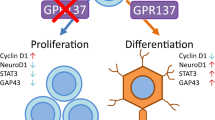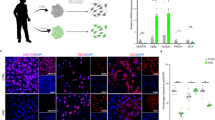Abstract
1. The limited lifespan of human embryonic brain (HEB) cells hampers their therapeutic use for the treatment of neurodegenerative diseases.
2. Stable expression of SV40 large T antigen (LTA) or E6E7 genes of human papillomavirus type 16 significantly increased the lifespan of HEB cells, but did not induce transformation.
3. The extended lifespan was triggered by changes in the expression of antiproliferative genes. We found that changes in the expression of p16 (INK4a), p21 (WAF1), p14ARF, and p53 tumor suppressor gene, but not p27 (Kip1), differed between the LTA- and E6E7-HEB cells.
4. Despite the induction of p53 RNA, p53 protein was undetectable in HEB-E6E7 cells. In contrast, p53 protein was increased in HEB-LTA cells as compared with the parental cells. Expression of p21 was, however, reduced in both cell lines.
5. While p16 was decreased in HEB-E6E7 cells, its expression was increased in HEB-LTA cells.
6. Despite these changes, HEB cell lines showed neuron-like morphological differentiation when the intracellular level of cAMP was elevated.
7. This suggests that the mechanisms for inducing neuronal differentiation are still intact in HEB-E6E7 and HEB-LTA cells. More importantly, differentiation signals can override the effects of viral oncogenes in HEB cells.
Similar content being viewed by others
References
Chin, L., Pomerantz, J., and DePinho, R. A. (1998). The INK4a/ARF tumor suppressor: One gene–two products–two pathways. Trends Biochem. Sci. 23:291–296.
Clarkson, E. D., and Freed, C. R. (1999). Development of fetal neural transplantation as a treatment for Parkinson's disease. Life Sci. 65:2427–2437.
Dorsky, R. I., Moon, R. T., and Raible, D. W. (2000). Environmental signals and cell fate specification in premigratory neural crest. Bioessays 22:708–716.
Foster, S. A., Wong, D. J., Barrett, M. T., and Galloway, D. A. (1998). Inactivation of p16 in human mammary epithelial cells by CpG island methylation. Mol. Cell. Biol. 18:1793–1801.
Freed, C. R. (2002). Will embryonic stem cells be a useful source of dopamine neurons for transplant into patients with Parkinson's disease? Proc. Natl. Acad. Sci. U.S.A. 99:1755–1757.
Hanahan, D., and Weinberg, R. A. (2000). The hallmarks of cancer. Cell 100:57–70.
Hansen, T. O., Rehfeld, J. F., and Nielsen, F. C. (2000). Cyclic AMP-induced neuronal differentiation via activation of p38 mitogen-activated protein kinase. J. Neurochem. 75:1870–1877.
Harms, W., Rothamel, T., Miller, K., Harste, G., Grassmann, M., and Heim, A. (2001). Characterization of human myocardial fibroblasts immortalized by HPV16 E6–E7 genes. Exp. Cell Res. 268:252–261.
Haupt, Y., Maya, R., Kazaz, A., and Oren, M. (1997). Mdm2 promotes the rapid degradation of p53. Nature 387:296–299.
Huschtscha, L. I., Neumann, A. A., Noble, J. R., and Reddel, R. R. (2001). Effects of simian virus 40 T-antigens on normal human mammary epithelial cells reveal evidence for spontaneous alterations in addition to loss of p16 (INK4a) expression. Exp. Cell Res. 265:125–134.
Imperiale, M. J. (2001). Oncogenic transformation by the human polyomaviruses. Oncogene 20:7917–7923.
Ivanchuk, S. M., Mondal, S., Dirks, P. B., and Rutka, J. T. (2001). The INK4A/ARF locus: role in cell cycle control and apoptosis and implications for glioma growth. J. Neurooncol. 51:219–229.
Kubbutat, M. H., Jones, S. N., and Vousden, K. H. (1997). Regulation of p53 stability by Mdm2. Nature 387:299–303.
Kumar, B., Hovland, A. R., Prasad, J. E., Clarkson, E., Cole, W. C., Nahreini, P., Freed, C. R., and Prasad, K. N. (2001). Establishment of human embryonic brain cell lines. In Vitro Cell Dev. Biol. Anim. 37:259–262.
Kurokawa, K., Tanaka, T., and Kato, J. (1999). p19ARF prevents G1 cyclin-dependent kinase activation by interacting with MDM2 and activating p53 in mouse fibroblasts. Oncogene 18:2718–2727.
Lundberg, A. S., and Weinberg, R. A. (1999). Control of the cell cycle and apoptosis. Eur. J. Cancer 35:1886–1894.
Magnaghi-Jaulin, L., Groisman, R., Naguibneva, I., Robin, P., Lorain, S., Le Villain, J. P., Troalen, F., Trouche, D., and Harel-Bellan, A. (1998). Retinoblastoma protein represses transcription by recruiting a histone deacetylase. Nature 391:601–605.
Mal, A., Poon, R. Y., Howe, P. H., Toyoshima, H., Hunter, T., and Harter, M. L. (1996). Inactivation of p27Kip1 by the viral E1A oncoprotein in TGFbeta-treated cells. Nature 380:262–265.
Mantovani, F., and Banks, L. (2001). The human papillomavirus E6 protein and its contribution to malignant progression. Oncogene 20:7874–7887.
McCaffery, P., and Drager, U. C. (2000). Regulation of retinoic acid signaling in the embryonic nervous system: A master differentiation factor. Cytokine Growth Factor Rev. 11:233–249.
Medema, R. H., Herrera, R. E., Lam, F., and Weinberg, R. A. (1995). Growth suppression by p16ink4 requires functional retinoblastoma protein. Proc. Natl. Acad. Sci. U.S.A. 92:6289–6293.
Munger, K., Basile, J. R., Duensing, S., Eichten, A., Gonzalez, S. L., Grace, M., and Zacny, V. L. (2001). Biological activities and molecular targets of the human papillomavirus E7 oncoprotein. Oncogene 20:7888–7898.
Nahreini, P., Hovland, A. R., Kumar, B., Andreatta, C., Edwards-Prasad, J., and Prasad, K. N. (2001). Effects of altered cyclophilin A expression on growth and differentiation of human and mouse neuronal cells. Cell. Mol. Neurobiol. 21:65–79.
Obermeier, A., Bradshaw, R. A., Seedorf, K., Choidas, A., Schlessinger, J., and Ullrich, A. (1995). Definition of signals for neuronal differentiation. Ann. N.Y. Acad. Sci. 766:1–17.
Patapoutian, A., and Reichardt, L. F. (2000). Roles of Wnt proteins in neural development and maintenance. Curr. Opin. Neurobiol. 10:392–399.
Prasad, K. N. (1991). Differentiation of neuroblastoma cells: A useful model for neurobiology and cancer. Biol. Rev. 66:431–451.
Prives, C., and Hall, P. A. (1999). The p53 pathway. J. Pathol. 187:112–126.
Pomerantz, J., Schreiber-Agus, N., Liegeois, N. J., Silverman, A., Alland, L., Chin, L., Potes, J., Chen K., Orlow, I., Lee, H. W., Cordon-Cardo, C., DePinho, R. A. (1998). The Ink4a tumor suppressor gene product, p19Arf, interacts with MDM2 and neutralizes MDM2's inhibition of p53. Cell 92:713–723.
Quelle, D. E., Zindy, F., Ashmun, R. A., and Sherr, C. J. (1995). Alternative reading frames of the INK4a tumor suppressor gene encode two unrelated proteins capable of inducing cell cycle arrest. Cell 83:993–1000.
Reddel, R. R. (1998). Genes involved in the control of cellular proliferative potential. Ann. N.Y. Acad. Sci. 854:8–19.
Robertson, K. D., and Jones, P. A. (1998). The human ARF cell cycle regulatory gene promoter is a CpG island which can be silenced by DNA methylation and down-regulated by wild-type p53. Mol. Cell. Biol. 18:6457–6473.
Saenz-Robles, M. T., Sullivan, C. S., and Pipas, J. M. (2001). Transforming functions of Simian Virus 40. Oncogene 20:7899–7907.
Sakaguchi, K., Herrera, J. E., Saito, S., Miki, T., Bustin, M., Vassilev, A., Anderson, C. W., and Appella, E. (1998). DNA damage activates p53 through a phosphorylation–acetylation cascade. Genes Dev. 12:2831–2841.
Sashiyama, H., Shino, Y., Kawamata, Y., Tomita, Y., Ogawa, N., Shimada, H., Kobayashi, S., Asano, T., Ochiai, T., and Shirasawa, H. (2001). Immortalization of human esophageal keratinocytes by E6 and E7 of human papillomavirus type 16. Int. J. Oncol. 19:97–103.
Scheffner, M., Takahashi, T., Huibregtse, J. M., Minna, J. D., and Howley, P. M. (1992). Interaction of the human papillomavirus type 16 E6 oncoprotein with wild-type and mutant human p53 proteins. J. Virol. 66:5100–5105.
Svendsen, C. N., and Smith, A. G. (1999). New prospects for human stem-cell therapy in the nervous system. Trends Neurosci. 22:357–364.
Whalen, B., Laffin, J. Friedrich, T. D., and Lehman, J. M. (1999). SV40 small T antigen enhances progression to >G2 during lytic infection. Exp. Cell. Res. 251:121–127.
Zerfass-Thome, K., Zwerschke, W., Mannhardt, B., Tindle, R., Botz, J. W., and Jansen-Durr, P. (1996). Inactivation of the cdk inhibitor p27KIP1 by the human papillomavirus type 16 E7 oncoprotein. Oncogene 13:2323–2330.
Zhang, Y., Xiong, Y., and Yarbrough, W. G. (1998). ARF promotes MDM2 degradation and stabilizes p53: ARF-INK4a locus deletion impairs both the Rb and p53 tumor suppression pathways. Cell 92:725–734.
Author information
Authors and Affiliations
Rights and permissions
About this article
Cite this article
Nahreini, P., Andreatta, C., Kumar, B. et al. Distinct Patterns of Gene Expression Induced by Viral Oncogenes in Human Embryonic Brain Cells. Cell Mol Neurobiol 23, 27–42 (2003). https://doi.org/10.1023/A:1022541017085
Issue Date:
DOI: https://doi.org/10.1023/A:1022541017085




